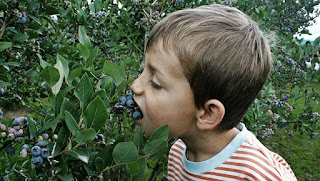Sacramento, CA – When Central Valley farmer Jim Jabernathy walks through his fields every morning, he expects to find the occasional mouse or even a corn possum or two. But these days he is more likely to find something that he considers to be an even greater pest: people. Calling themselves “connected eaters”, these proponents of the latest fad diet are growing in number and leaving farmers like Jabernathy no choice but to take drastic measures.

A child eating blueberries straight from the bush mere moments before being mauled to death by an enraged mother bear. The bear, whose confused cub had been following the child’s mother and eating blueberries straight from her pail, was oblivious to this children’s literary reference.
“I thought I’d seen it all from folks around here,” Jabernathy explained. “I’ve seen a lot of fad diets in my time, from paleo to those people who don’t eat anything made with chemical bonds. Heck, my daughter even started strafing last year. But this beats all. Just yesterday I done ran off about thirty of ’em from my best kale patch. They were like locusts!”
What is connected eating? And why are farmers installing razor wire fences and training perimeter defense badgers? Proponents are quick to point out that eating connected food has numerous health benefits, but are they worth the risk? Proponents think so. But why? And how? What?
Connected eating involves the consumption of unharvested food that is still attached to the so-called “mother plant”. Believers say that simply eating unprocessed or even raw whole foods isn’t enough. They want to experience the severing of the food’s connection to it’s life source, and to absorb its essence as well as its nutritional content. Some proponents liken the experience to Earthing, the science of connecting to the Earth’s natural energy in order to achieve vibrant and long lasting true health.
Dietary folklorist Allen Levitzky, author of Food Tribes: How What We Eat Defines Who We Are and What the Future Will Be, is an expert in fad diets and irrational appeals to nature as a guide for human behavior. He sees connected eating as an example of evolution in mankind’s dietary journey, but cautions that many branches in the evolutionary development of social behaviors, just as with physical changes in an animal species over long periods of time, end up being dead ends. “The belief that nature holds the key to health and longevity has been around since the first caveman looked at the world around him, not with fear but with curiosity…and hunger. Oooh, I like that. Use that one.”
Farmers aren’t the only ones that are concerned about the connected eating trend. Medical experts, like Sacramento interventional culinologist Mort Fishman, warns that the risk of foodborne illness may be increased and that failing to at least rinse connected food prior to eating it could result in exposure to toxic pesticides. “I tell my patients who are determined to eat connected food to limit meals to right after a hard rain.”

Actress and connected eater Jenna Ortega, shown here in a scene from the hit series The Wednesday Chronicles
Despite the risks, connected eating has continued to increase in popularity, especially after a recent viral TikTok video showing Jenna Ortega pulling radishes from the ground with her bare teeth while in her costume from The Wednesday Chronicles. Farmer Jabernathy, who prefers his food good and dead, doesn’t mince words when it comes to the new trend. “I drive through a lot of farmland, and every week I see more of them crawling around on their hands and knees, covered in dirt and partially chewed spinach like animals. Just like a herd of mindless animals.”
A mouthful of reality?
Obviously this is nonsense, but there really are some wacky diet fads out there based on magical thinking rather than established science. There are a lot of absurd beliefs regarding energies and essences as well, and “connected eating” combines all of that into something that probably could/will be a thing at some point in the future. It’s not all that different from the “magnetic diet” for example:
The magnetic diet consists of such food substitutes as rays and oxygen, which can be easily assimilated and converted into energy by the latent life forces in the body. Magnetic foods give energy more quickly than solids and liquids, which are less easily converted into life force
Connected eaters would likely boast about how effective it is as a way to lose weight. Of course, this would boil down to difficulty consuming a lot of calories eating this way plus the increased caloric burn that comes from all that bobbing for beets in the Sacramento soil. All diets, even this one, are more about math than magic when it comes to weight loss.
Now that I think about it, if someone ate enough connected food to maintain a healthy weight, it would essentially just be a nice way to experience nature and eat mostly plants. I don’t want to think about how one would incorporate animal products into this diet, however. Regardless, I think I need to talk to a good lawyer and get this intellectual property locked down before Mark Hyman gets a hold of it.
Happy New Year everybody!

